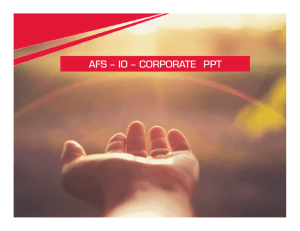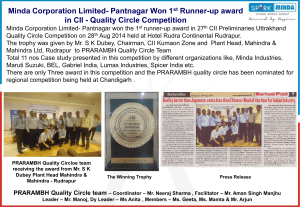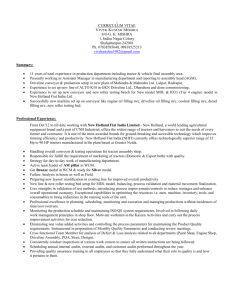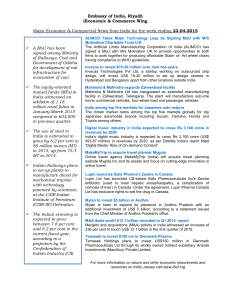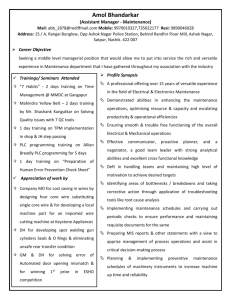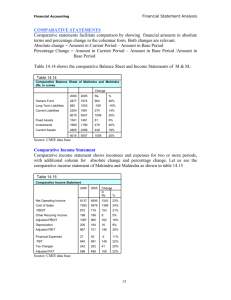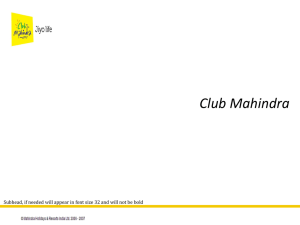February 12, 2016
advertisement
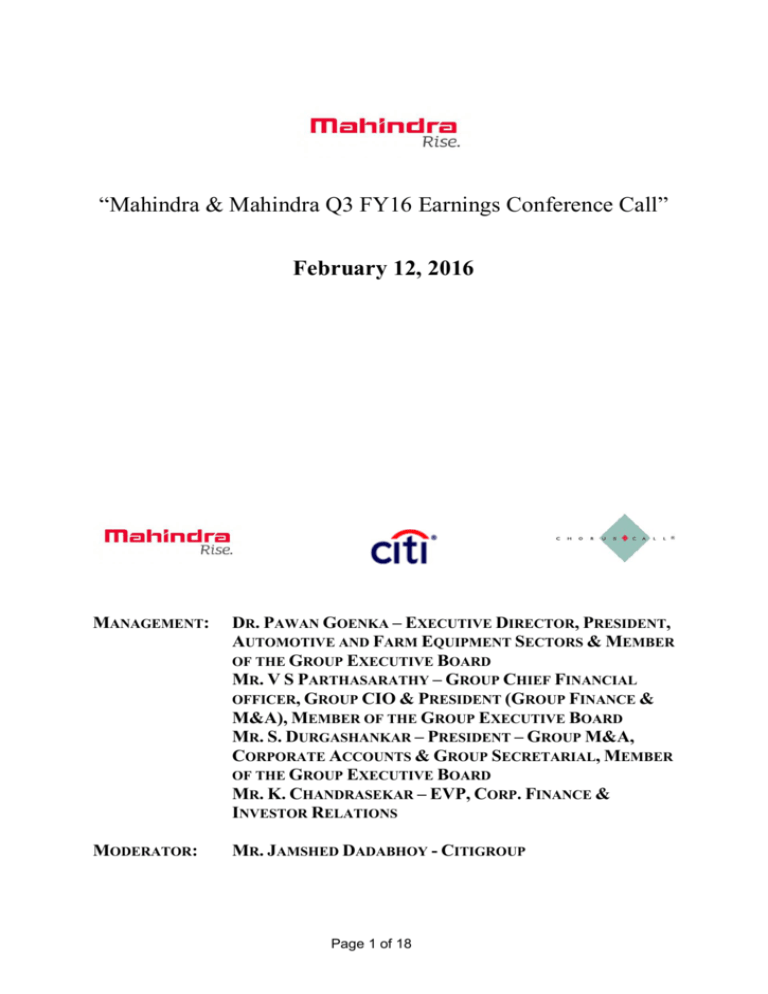
“Mahindra & Mahindra Q3 FY16 Earnings Conference Call” February 12, 2016 MANAGEMENT: DR. PAWAN GOENKA – EXECUTIVE DIRECTOR, PRESIDENT, AUTOMOTIVE AND FARM EQUIPMENT SECTORS & MEMBER OF THE GROUP EXECUTIVE BOARD MR. V S PARTHASARATHY – GROUP CHIEF FINANCIAL OFFICER, GROUP CIO & PRESIDENT (GROUP FINANCE & M&A), MEMBER OF THE GROUP EXECUTIVE BOARD MR. S. DURGASHANKAR – PRESIDENT – GROUP M&A, CORPORATE ACCOUNTS & GROUP SECRETARIAL, MEMBER OF THE GROUP EXECUTIVE BOARD MR. K. CHANDRASEKAR – EVP, CORP. FINANCE & INVESTOR RELATIONS MODERATOR: MR. JAMSHED DADABHOY - CITIGROUP Page 1 of 18 Mahindra and Mahindra Limited February 12, 2016 Moderator: Ladies and Gentlemen, Good Day and Welcome to the Mahindra & Mahindra's Q3 FY16 Earnings Conference Call hosted by Citigroup. As a reminder, all participant lines will be in the listen-only mode, and there will be an opportunity for you to ask questions after the presentation concludes. Should you need assistance during the conference call, please signal an operator by pressing ‘*’ then ‘0’ on your touchtone phone. Please note, that this conference is being recorded. I would now like to hand the conference over to Mr. Jamshed Dadabhoy from Citigroup. Thank you and over to you. Jamshed Dadabhoy: Hi Everyone, Good afternoon. So we have got a full lineup of M&M management with us today. We have got Dr. Goenka – ED and President for the Automotive and Farm Equipment Sectors, we have Mr. V S Parthasarathy – Group Chief Financial officer, Group CIO & President (Group Finance & M&A), Mr. S. Durgashankar – President - Group M&A, Corporate Accounts & Group Secretarial and we have Mr. K. Chandrasekar – EVP, Corporate Finance & IR and then we have other senior management and the IR team as well. I will now hand over the call to Mr. Parthasarathy for his presentation and opening remarks. Over to you, Partha. V S Parthasarathy: Thank you and a very warm welcome to all of you for this quarterly analyst call. I will take about five minutes to take you through a broad environment scan and also about the Q3 financial highlights. First, about the economy scan. The global economy sends mixed signals, the World Bank has revised the global growth forecast down to 2.9% from 3.3% earlier. Slower growth in emerging markets drive global growth forecasts down and persistent slowdown in China, though still the growth of 5% or so remains as a growth in China. On the cost side however, the global crude oil prices touched new lows due to oversupply, weakening demand especially in China, so benign material cost is an important element of the profitability across the world and that is being to some extent held. Indian economy’s positives are that, inflation is still in the range, however the increasing trend is a little bit to watch. Benign commodity prices, growth going up in quarter three is being revised upward to 7.6 versus the earlier 7.5 and auto industry is seeing a growth of 9% to 10% in Q3. The concern is in terms of the rural India sentiments and demand which is subdued, which is resulting in continuing de-growth in tractor industry, even in Q3 FY16. However, the revenue growth was much less in Q3 as compared to the earlier quarters. IIP growth slipped to (-3.2) in November after recording 9.8% growth in September, but overall we see an increasing IIP trend. Now, let me go away from the macroeconomics and Indian economics to financials. I will talk about M&M plus MVML, jointly for reasons already explained, as it gives us comprehensive review and view. If you see the financials in the stock exchange, as against a growth of 5% in FES and 15.4% in auto versus the previous year quarter three. Net revenue is higher by 15% versus Q3 of last year, 10,466 crores versus 9,105 the previous year, against a revenue growth of 15%, EBITDA grew by 31%, 30.9% to be exact, at 1,414 crores and PAT before EI was higher by 23% at 821 crores. You would know that last year we had Q3, an exceptional item of Page 2 of 18 Mahindra and Mahindra Limited February 12, 2016 299 crores or 300 crores because of MES share sale and if we consider that you see on a PAT level after exceptional item to be lower, however from an operational point of view we were 15% up top-line, 31% up EBITDA, 33% up PBT and 23% up in PAT. There is also some onetime and significant expenses in Q3 which is in terms of bonus provisions which come retrospectively, there was a difference in exchange or exchange provision being made, there was couple of other items similar in nature, all of which add up to roughly about 100 crores, the result that I talked to you is after providing for that 100 crores. So, this has been a great performance both in a subdued economy, both on the top-line and the bottom-line and I would like to compliment our AFS team for managing cost and launches. Coming to segment result, auto segment 15.4% growth, domestic volume grew actually 15.2% and export by about 20%. Revenue was 21.3% higher at 6,917 crores and auto segment grew by 705 crores in result terms, up 46% versus previous year, 21% higher in revenue, 46% in profit. FES segment grew by 5% on the top-line or volume and within that domestic, I told you that the industry was at negative growth but FES volumes grew by 6% in domestic and there was a small de-growth in the export by 15%, net on an overall basis 5% volume growth. Domestic volume and that resulted in the overall revenue being higher by 4.4% at 3,582 crores. FES segment result and revenue growth of 4.4% was up by 10.8% at 548 crores, another good performance in what is a tough environment. In the financial metrics, ROCE went up this quarter to 16.7% versus previous year 14.2% and debt equity ratio on a net level we were cash positive, but on a gross basis it was 0.2 ratio. This time I am not going to talk about consolidated financials as results of two group listed companies, Ssangyong Motors and Mahindra CIE is still pending and post the results I will circulate the financials to you, and if you so desire we can have a separate call on the consolidated results. This has been a long time but I am very excited by our top-line, middleline and bottom-line growth. With that, thank you and over to Pawan for his comments. Dr. Pawan Goenka: Thank you, Partha. As you have heard from Partha that we have had very good financial performance this quarter, and to support that we have also had a good market performance during the quarter. Let me give you a little bit of overview. I am repeating perhaps couple of numbers that Partha has already talked about. So, the environment I believe in this quarter was very good for the auto side with two successive quarters of GDP upswing, subdued oil prices, benign commodity prices and interest rates reasonably good aided with a lot of new launches that have happened and therefore almost everything that one would ask for to get a good growth in the auto segment was there. and therefore the segment has witnessed a good growth, except for SCV, small commercial vehicle, and for motorcycles. On the rural side, all these positives were there, but Rabi sowing was less than what was expected and therefore there was not the kind of growth that one was expecting in Q3 in tractors and therefore as of YTD nine months the tractor industry is down about 14.4% which is worst that we have seen in 13 years in terms of tractor industry. And therefore later on Page 3 of 18 Mahindra and Mahindra Limited February 12, 2016 we will talk about that we will revise our forecast for rest of this year. As I mentioned earlier that Rabi sowing was less by 3% and that obviously had an effect on tractor sales. So now going to FES, overall for FY16 YTD around 14.4% and amongst the six or seven largest states, three of them de-grew more than the industry average that are UP, MP and Maharashtra and three of them de-grew less or had a minor growth compared to industry which is Rajasthan, AP and Bihar. For FES for Mahindra business, Q3 domestic volume had a growth of 6.2% against industry de-growth of 1.5% and therefore it allowed us to catch up on the market share drop that we have had in the first two quarters and right now we are standing at about 42.7% market share which incidentally is the highest market share that we have had in 16 quarters and also obviously better than what we had a year ago this quarter and we are now plus 0.5% YTD nine months. MUSA, which is our US subsidiary continues to do very well. However, China does have some signs of strength for the time being, the overall agri sentiment though is down and therefore we do not expect the kind of growth that we had hoped for in Q4 either. The material cost for tractor and same thing for automotive also continued to remain benign, we have not taken any selling price increase in tractor for the whole of this year up to now. One of the good achievement for us in operations during this year which actually had an adverse impact on financial performance was inventory reduction. We have reduced our inventory within our factory and stock yard which is the company inventory by 19,000 tractors during this quarter, which means more than one month, almost a month's sales is what we have reduced the inventory by. Which means that the LOH item becomes negative for us and therefore there is some financial loss because of our production is much lower than the sales. The agri business continued its revenue growth, we had 47% growth during the quarter, 33% overall YTD growth that we have seen, especially our listed subsidiary EPC had a very good quarter this year, it grew by 31% in Q3. Our joint ventures that we have with HZPC for sweet potato and MUPL for fruits is moving along as per the plan. And we have announced today, and we can talk about that more in Q&A if there is an interest that we have announced today that we will be moving all of our agri business from M&M Limited to MSSL and consolidate everything except for EPC under MSSL, MSSL by the way is a 100% owned subsidiary of Mahindra and Mahindra. Moving now to automotive sector very quickly, the passenger vehicle segment had a doubledigit growth for the first time after 14 quarters, though it has been growing for some time but double-digit happened for the first time after 14 quarters. MHCV continued to grow more than 20%, sixth quarter in a row, so this is a very good robust growth that we have seen in MHCV industry, but yet it has not reached the F12 level which was about 75,000 trucks of 25 ton and above, it is still 19% below that level. LCV continues to be negative territory, the small commercial vehicle, pickups though have come into positive after about eight quarters. In the two wheelers, motorcycles are very slow, there is just a marginal growth but scooters have done reasonably okay. A big thing for us was that last year about this time we had talked about nine new launches in financial year 2016, those nine launches have now been done, the last one was KUV100 launch Page 4 of 18 Mahindra and Mahindra Limited February 12, 2016 that happened on 15th of January and I think that is what has contributed to the 15.2% growth that we have seen in Q3. For the fourth consecutive quarter we now see HCV quarterly volume of 1000 which is very encouraging for us because it is giving us a signal of HCV finally reaching a point where we see an uptick happening and I will talk a little bit more about that later. Bolero continues to do well, in spite of some concerns that some of the people had because of TUV300, and export also in auto had a good growth of 20% in Q2, and even a larger growth overall YTD. I am sure there will be interest in how KUV is doing, so let me pre-empt a question that somebody may ask later. We have so far about 18,000 plus bookings, this is about two days ago, about 18,000 bookings. That means that we are booked in terms of production capacity till about end of April. We are getting approximately 350 to 400 new bookings ever day against a current capacity which will be about 200, so we are getting the booking of current capacity. And the diesel petrol ratio is 55:45. For TUV300, we have done total booking YTD January 2016 of almost 19,000 vehicles, if you recall this vehicle was launched in September end, so about 19,000, we are running at a pace of approximately on an average 4,038 thereabouts, so therefore TUV 300 has also performed as per our expectation, both of these products were very important products for us to get volume and market share back to where we wanted to be. Pickup, it continues to have a very good market share of about 70%, we have launched two new products in that range now, one is Supro and one is Imperio launched in Q4 and Q3. As I reported in the past meeting, that because of Jeeto we now have a very healthy market share in sub-1 ton category where our market share has reached almost 30% level where we were earlier at about 8% to 10% level. Material cost, just like in tractor, there was a de-growth or deduction in material cost monetary prices of about 1.6% - 1.7%, in the auto side though we have take about 1.7% increase in selling price YTD Q3. Inventories for auto are also under control. On the truck side, we have increased our market share cumulative to about 3.1% from last year average and Q3 specifically we are 3.7% market share, we are growing at a pace of about 60% against industry growth of about 35%, though it is a very small base but it is very encouraging for us to see that happening. So we believe that now we are kind of turning the corner on the truck. You may know that we have had a very aggressive new product that we have launched in the auto expo called ‘Blazo’ where we have also given some guarantees on fuel efficiency as well as on service turnaround time. Mahindra Reva, of course the volumes are very small but with the current focus on clean vehicles and clean air, there is some demand that we are beginning to see on the electric vehicle side. Page 5 of 18 Mahindra and Mahindra Limited February 12, 2016 So that is about what I wanted to tell you in overall nutshell. Now, we can get into Q&A. But I just want to reiterate that this quarter was a very good quarter in terms of market share, in terms of control on various things in the business such as inventory, working capital, free cash flow, impact of free cash flow was very healthy during this year, that we have not talked because about. So we are quite happy with the overall quarter has gone. Thank you. Moderator: Thank you very much. We will now begin the question-and-answer session. Our first question is from the line of Chirag Shah from Edelweiss. Please go ahead. Chirag Shah: Sir, my question is a housekeeping one on this inventory accounting adjustment that we did, but for this inventory reduction our margins would be higher by 100 bps, is it a right analysis or understanding of the commentary that you made? V S Parthasarathy: As compared to? Chirag Shah: So, the reported margins that we have done, had this inventory reduction activity not taken place, your margins would have been higher by 100 bps or something like that? V S Parthasarathy: Yes, that is why I wanted to be clear. So, if only you take tractors and if they did not reduce a single stock, then the margin impact would be between 100 to 150 bps on the company's balance sheet. Chirag Shah: 100 bps to 150 bps for the company, and should we assume that the inventory adjustment phase is behind for tractors? V S Parthasarathy: So, are we on the right inventory level? The answer is yes. Dr. Pawan Goenka: Let me just add here, that in tractor, Q4 always has an inventory reduction, because there is a pre build that happens because of festive season. So, in the month of August-September one always builds more than on self and then you sell from that inventory in Q3, in Q2 you build inventory and in Q3 you sell them. So this is nothing specific extra that has happened, perhaps we have done a little bit more correction this time but it is a normal trend. When we talk about 100 basis points it is a combined effect of increasing inventory in Q2 and reducing in Q3. So therefore Q2 had slightly higher OPM than what would be natural if we have had same production as sales and Q3 is lower. So the delta of the two together is about 100 basis points. V S Parthasarathy: So that is why I asked him, is it comparison, you understand. So Pawan has explained that much better. But suppose these results did not have any stock reduction then we would have had 150 basis points impact. Chirag Shah: And all the commodity benefits till now whatever is there in the price, so going ahead we will not be having any major benefits, is it right or there is a lag effect on the commodity side? Page 6 of 18 Mahindra and Mahindra Limited February 12, 2016 Dr. Pawan Goenka: So, whatever has happened up to now is accounted for, but that does not mean that some further reduction in commodity prices will not happen, though conventional wisdom right now is that we have reached the bottom of commodity price reduction and therefore there remains flat or maybe have a marginal increase going forward, but one never knows. V S Parthasarathy: Just to get a perspective on that, let us take only oil, there are things which are said that oil could go down as low as Rs.20 while there may be one or two which has an upward bias and most of them have downward bias, so similarly every commodity has some biases, it is benign at this point of time. Moderator: Thank you. Our next question is from the line of Binay Singh from Morgan Stanley. Please go ahead. Binay Singh: I am sorry I would not catch your point on that 100 crores expense that you mentioned, is my understanding right that the 700 crores of staff cost should have been lower by 100 crores adjusting for bonus act? V S Parthasarathy: So bonus I said was one item, and the bonus amount also let me mention is 22 crores, the impact which is being booked in this quarter for seven quarters is 22 crores, so I mentioned more because we are doing in one shot for all retrospectively, but going forward quarter-on-quarter it maybe a 3 crores impact every quarter but this is one-time impact for seven quarters put together. Similarly, we have some other item, I said difference in exchange of 32 crores, so this is on account of the loans that we carry in our books, the revaluation of that because of the exchange going up, it is a significant amount in the quarter. We also have done a physical verification of fixed assets and taken a diminution in value which is another one. And the last one is, we got something which is an incentive which we have not said, we have reversed it in the quarter and we hope in future we will get it back, but as of now we take it conservative accounting entry. I said all these amounts of one-time nature put together is close to 100 crores. Binay Singh: And sir like you mentioned 22 crores is in staff, so remaining is in the other expenses, right? V S Parthasarathy: Yes, the remaining I would say is in the other expense. Moderator: Thank you. Our next question is from the line of Jatin Chawla from Credit Suisse. Please go ahead. Jatin Chawla: Just one quick clarification on the earlier question and then I will go to my question, the physical assets value, diminution of that, has that been taken also in other expenditure or that is in depreciation? V S Parthasarathy: That is in the other expense, it is a write-off. Jatin Chawla: So the increase in depreciation is more to do with the new die for the new launches? Page 7 of 18 Mahindra and Mahindra Limited February 12, 2016 V S Parthasarathy: Let me explain that, increase in depreciation and on behalf because of amortization, because new product launches have come on stream, for example last quarter big one was TUV but over the year we have had nine launches which were not the case the previous year and the fixed asset capitalization also falls in line with the launch of these vehicles. So if you look at your increase for the quarter, roughly about 50 crores is because of this amortization increase and increase because of launches in depreciation, the balance is normal depreciation. Jatin Chawla: And just a quick question on the agri business consolidation that you have done, if you could just highlight the rationale and going forward what are the kind of synergy benefits that you see from the same? V S Parthasarathy: So agri consolidation, first to give you background that we have some businesses in M&M, some business in MSSL or Mahindra Shubhlabh Limited. The idea was to bring all the businesses which were lying either in M&M or MSSL under one roof under MSSL because the businesses have come off scale and it would make immense sense to put all the business together under one roof and that is done now in MSSL. And couple of reasons in terms of putting it is that, we put it under a specific focused group, it gets a lot of attention that it would not necessarily get if it was part of a bigger, larger group and now with after being growing to what somebody quoted in the press meet today as adolescent across and it is becoming close to an adult is better to house them in a separate company. It also allows me to leverage the potential these businesses have to offer. Dr. Pawan Goenka: It is like moving away from parent house to own house. V S Parthasarathy: In his own house, absolutely correct. So it also gives provision opportunity to fully leverage the potential, these businesses and offer and best function as an end to end provider in the agri value chain and this is also one of the big benefits that we will have by bringing it together. From a CFO point of view, I also wanted to say that systems and processes of agri business is very different from what we have for the other businesses. Now by bringing this into a single group, we will be able to focus on systems and processes which are uniquely required for this business. Last but not least, it is a very good way of value creation opportunity that we are providing for the future, we can bring in players, somebody pointed out over a period of time we could list this and so on. Dr. Pawan Goenka: Just like to add two more things to what Parthasarathy has said, one is that from analyst view point I think it brings more transparency in reporting also because so far even though we had talked about the top-line, of and on, but in a little bit of a generic way and we had never talked specifically about P&L coming out of agri, now it will be accessible to you when agri is a separate legal entity. And second thing is about people that we need for running agri business, the nature of people, the nature of the way the compensation works and all are very different from what auto and tractor is which becomes very difficult to manage when you are part of a very large business of auto and tractor. So agri being separate now it just facilitates the aligning that the people policies to what the agri business norm or agri industry norms are. Page 8 of 18 Mahindra and Mahindra Limited February 12, 2016 V S Parthasarathy: So only one clarification I want to add, more because I must mention this, there is a company called EPC which is a listed company, this is in micro irrigation, this remains as a separate entity, all the agri businesses other than EPC is what is being brought under MSSL. Jatin Chawla: Can you broadly share what was your top-line of MSSL after this exercise, roughly. Dr. Pawan Goenka: For the year we will probably end the order of 650 - 700, including the two joint ventures that come under MSSL which are very small. Moderator: Thank you. Our next question is from the line of Aditya Makharia from JP Morgan. Please go ahead. Aditya Makharia: Sir just in light of this Rabi sowing which has declined, so apparently rural incomes will remain under pressure perhaps for two more quarters. In that light, how are you seeing tractor sales because you are reporting positive growth. Dr. Pawan Goenka: So, last year Q4 was almost like a disaster for the industry, given with the base that we had we do expect the industry to grow in Q4, but nowhere near what we had thought three months ago because of what has happened in the Rabi crop and therefore we are saying that from current level of being 13.5% down the industry will probably end about 10% down for the year. Next year, it depends very much on what the monsoon forecast is going in to the sowing season and what happens to actual monsoon. And as we said earlier that this year monsoon becomes more important than ever before and there has never been a three monsoon failures in a row, so we are hoping that statistics will not revert itself this time and we will have a neutral to a positive monsoon this time. So it will depend a lot on that. So if that happens then perhaps we will get back on the growth path, but that does remain a big question mark. Aditya Makharia: And sir any states witnessing growth? Dr. Pawan Goenka: Andhra Pradesh, Tamil Nadu. Aditya Makharia: Just last question for Mr. Partha, this is little on the housekeeping side. In terms of the inventory run down you mentioned that it is actually negative for margins in a sense, so can you just kind of explain the rationale a little? V S Parthasarathy: Rationale of reducing the inventory? Aditya Makharia: Kind of how that impacts on margins. V S Parthasarathy: So you have something called as labour and overheads that you capitalize whenever an inventory comes in, the reverse is true when you reduce the inventory, so there is less capitalization. So when that happens there is a negative impact on the P&L. If you need more details I can take it offline, but that is what happens, when you reduce the inventory you have an impact of L&OH overheads. Page 9 of 18 Mahindra and Mahindra Limited February 12, 2016 Moderator: Thank you. Our next question is from the line of Jinesh Gandhi from Motilal Oswal Securities. Please go ahead. Jinesh Gandhi: My question pertains to, first is on the raw material cost side, if we see as a percentage of sales there is a sizable increase on QoQ basis and this is despite a contribution of tractors and improving. Is there any cost pressures which we are not aware of or it is just a mix impact there? V S Parthasarathy: So first and foremost is I think, I do not know whether you are looking at quarter-on-quarter, basically after looking at L&OH after taking the impact of the inventory reduction, but per se you should not see any margin pressure on a broad basis because the material cost is benign, there is some impact of mix but nothing which majorly changes it, on a company level I am talking and not on a segment level. So broadly my answer would be that it should be L&OH which is crossing this thing, though I keep repeating and requesting, look on year-on-year basis, do not look on quarter-on-quarter basis. Jinesh Gandhi: So when you said 100 to 150 basis points impact of L&OH….I mean that is on YoY? V S Parthasarathy: So I think that is why I was very conscious when I said it, suppose I had not done how much margins have gone up versus if we had done it, so in a sense that is this quarter's impact on the previous quarter in a sense. Jinesh Gandhi: Because YoY also, I mean when you compare with third quarter last year there would be similar run down of inventory in tractors right? V S Parthasarathy: Yes, that is why Pawan clarified that please be conscious about what you are comparing to. Dr. Pawan Goenka: And just want to go back to the previous question on the states with growth in tractor, I had answered two states, Andhra Pradesh and Tamil Nadu, in addition to that Orissa also had a growth, and Assam, though it is a very small state also had a growth. Jinesh Gandhi: And two clarifications, one is with respect to auto segment price increase of 1.7%,that is nine months FY16? Dr. Pawan Goenka: Nine months, yes. Jinesh Gandhi: Any price increase in January? Dr. Pawan Goenka: No, we have not taken any price increase in January, last price increase was in October. Jinesh Gandhi: And second clarification with respect to the 18,000 bookings and 250 to 300 bookings a day was for KUV? Dr. Pawan Goenka: KUV, right, 300 to 350 and not 250 to 300. Actually it is more like 350 to 400, not even 250 to 300. 350 is average. Page 10 of 18 Mahindra and Mahindra Limited February 12, 2016 Moderator: Thank you. Our next question is from the line of Govind Chellappa from Jefferies. Please go ahead. Govind Chellappa: Just a small clarification before I come to my question, this inventory change happens every year in the third quarter, it goes up in second and comes down in third, any reason we are mentioning it specifically this time? V S Parthasarathy: That was in response to a question, so we have not mentioned it specifically. The key thing that I wanted to point from a segment result point of view, if you take the Q2 inventory which went up and the Q3 inventory which came down, if you take both the quarters into account and say what is the net impact, that is the impact that we talked about which is 100 basis points. Govind Chellappa: No, I was just wondering if there is any accounting change that is coming up next year. V S Parthasarathy: No. Govind Chellappa: So there is no change in the way you account this under the new accounting norms next year? V S Parthasarathy: No. Dr. Pawan Goenka: Just want to make sure that nobody misunderstands on what we are saying on this, the 100 basis points is the combined effect of inventory going up in Q2 and coming down in Q3. If you only look at inventory coming down in Q3, not the Q2 going up, the effect will be 50 basis points roughly. So if you were to look at Q3 OPM, standalone and not compared to Q2, and say what will it be if there was no inventory reduction, we have not done this calculation, approximately the effect will be 50 basis points. If production was equal to sales in Q3, effect will be about 50 basis points. Govind Chellappa: Sir my question is on both KUV and to a limited extent on TUV, so overall industry is not growing much except with new products, so in your consumer survey what would those consumers have bought otherwise, especially the KUV consumers? Dr. Pawan Goenka: KUV100, the competition set or that consideration set, most customers who come to buy this vehicle would be considering either or, or maybe both Swift and Grand i10, these come the closest to KUV100 in terms of price positioning and the size of the vehicle, so that will be our biggest consideration set comparatively. Of course there are some who are considering even like a bigger vehicle and look at KUV100 and say, for much lower price I am getting roughly what I want, so there are some of that also, but primarily it will be Swift and Grand i10. Moderator: Thank you. Our next question is from the line of Hitesh Goel from Kotak Securities. Please go ahead. Page 11 of 18 Mahindra and Mahindra Limited February 12, 2016 Hitesh Goel: Sir basically you are referring to full cost accounting, basically production is equal to sales, there is no impact which comes on margins because the production is lower than sales in this quarter so you had a negative 50 bps on the margin? V S Parthasarathy: Yes, correct. Hitesh Goel: Just wanted to clarify, this is on the company level margins or this is only on tractor level margin you are talking about? V S Parthasarathy: 50 basis points will be company level. Hitesh Goel: And sir, can you just give the order book for the bookings of KUV100, you said 350 to 400 per day? Dr. Pawan Goenka: Approximately the bookings that we have total, about 18,000 gross, there are always some cancellations that happen in any booking, but 18,000 is gross, some will get cancelled for sure. So assuming about 20% cancellation, that is an assumption, we are booked till about end of April based on the current capacity that we have in the plant. Our order intake is averaging about 350, maybe a little more than 350, our current capacity is trending towards 200, that means roughly every day we have one more day of waiting list getting added, just to put that in perspective. Just to go beyond your question, because somebody may want to know this, capacity that we have planned for right now is 200 vehicles a day, 5,000 vehicles in a month, we are trending towards that capacity and we will reach that level during this month. And after that we will stretch that level till about end of July and in August month, mid-August to late-August we will increase capacity from 200 per day to 300 per day, and right now we have no plans to go beyond 300 per day, we are going to watch our orders to stabilize and depending on where it stabilizes we will decide whether it is advisable for us to increase capacity beyond 300 per day. Hitesh Goel: And sir petrol and diesel is 50:50 you said, right? Dr. Pawan Goenka: No, 45 petrol and 55 diesel in terms of demand. Moderator: Thank you. Our next question is from the line of Amyn Pirani from Deutsche Bank. Please go ahead. Amyn Pirani: Sir my question is on your models, obviously last you had given a guidance of a very strong model launch line up of nine models and you have I think completed all of it, as we move into next year obviously you will have a positive effect of these launches which have happened over last six months, but at the same time competition is also launching quite a few vehicles in the compact UV segment. So next year are you giving any indication as to the number of refreshes or any model launches that you may also have or are you happy with your line up for now? Page 12 of 18 Mahindra and Mahindra Limited February 12, 2016 Dr. Pawan Goenka: We are very happy with the lineup that we have, in fact if you look at the model lineup that we have, we probably have the most refreshed and most new model lineup and if I were to take few more seconds on this question, because it is an important question, I will walk you through our SUV lineup starting KUV100 which is brand new of course, Bolero which is evergreen, TUV300 which is brand new, Scorpio which was refreshed in September 2014 is only 1.5 years old and then XUV500 which was refreshed during this year, so it is less than one year old. So in our overall lineup of UVs, our oldest, except for Bolero, our oldest model is only 1.5 years old and therefore there is no need for us to do anything else and there is no space left for doing any other product because we are covering from 3.7 meter to 4.7 meter, and everything in between. So we are quite well set in the UV or SUV lineup. When I talk about the commercial vehicles line up, Jeeto which is a product that was launched this year, so less than one-year-old, we have Maxximo, we have after that our pickup where we might do a refresh launch during that year, that we are still deciding, then we have the Supro which was launched this year, we have Imperio which was launched this year. So again, we have a reasonably brand new model portfolio offering this year and therefore we do not see any need, and again, our portfolio is full from 0.5 ton to 3.5 ton and everything in between, there is no room for any further sort of variants being launched, everything is very well covered. So in both of these segments, that are our primary segments, we have a significantly stronger and newer line up that anybody else in the competition, and therefore we believe that we for the time being are going to be focusing on leveraging the opportunities that we have for volume growth coming out of these launches that we have done and that is where the focus will be, that does not mean that we will not do some refreshes and some minor interventions, but there will be no major interventions that will happen in the product portfolio for the coming year. Amyn Pirani: That is helpful and we do expect that his lineup will have a strong impact in the coming year. Sir, any indication of when the XUV based coupe that you showed at the Auto Expo, any timelines for that if you can share? Dr. Pawan Goenka: Well, when we had put that in the Auto Expo, it was not put with the intent of producing it, it was just a show car. But we got very positive feedback in the Auto Expo and therefore we are right now, in fact everybody is recovering from the Auto Expo, but once we recover from Auto Expo we will huddle to see whether there is enough of a business case to want to invest in producing it. As you know that few hundred people liking it is not enough to justify launching a product, we have to ensure that there will be enough people wanting to buy the product long enough to justify an investment in the product and that call will be taken in the next three months or so on whether we want to produce it. If we decide to produce it, my guess is it will be about 2.5-year project. Moderator: Thank you. Our next question is from the line of Pramod Amthe from CIMB. Please go ahead. Pramod Amthe: Two questions, one, you have done some restructuring at the MVML which you have taken to the results, want to check what is the process, what is the action taken, especially in the context Page 13 of 18 Mahindra and Mahindra Limited February 12, 2016 that MVML profits have come down over last two, three years’ period, does it still make sense to keep it as a separate subsidy? V S Parthasarathy: So, it is currently a 100% subsidiary of M&M, and anyway the results that we are declaring is a combination of M&M plus MVML put together. So from that perspective it does not matter whether it is together or separate. As far as the profits are concerned, wait, we are already declaring that, you know M&M's profit and you know MVML's profit, so we will meet after a break. Dr. Pawan Goenka: So just to put that in perspective on a more serious note, this year we have launched out of MVML plant the TUV300, the KUV100, the XUV500 refreshed, the new age XUV500, the automatic XUV, the Imperio and the Supro. So you can imagine that all our large volume launches that have happened out of MVML plant and therefore naturally one would expect to see a significant increase in volume coming out of MVML. And as you know that we had committed to invest in Phase II of Chakan expansion and that expansion is happening right now. So therefore the MVML situation would be looking very different here down the line. Pramod Amthe: And there are some expectations in the Budget for rural stimulus, what would be your wish list or based on your judgment on the rural market, what can really revive the rural market going forward? V S Parthasarathy: So wish list is very simple, given a lot on two fronts, on what would be the stimulus that will be required for the rural, and second is what will be required for kind of kick starting it from ancillary point of view. So I would start with the ancillary. Infrastructure and infra projects, and big mega projects seeing the light of day and money flowing into it so that the rural employment, additional income opportunity all start flowing in, that is going to be a big enabler and I hope I will see a lot of stimulus both in and outside the Budget, but very quickly, that is one big deal. The second one is, so the policy impact for the rural market is something that we will look forward very strongly in the Budget. MSP going up is an important aspect for the rural market and what is done to enable. But having said all this, I think Budget is one major impactor, the major impactor is monsoon, and between the two I will take monsoon anytime. Dr. Pawan Goenka: I will just a little bit more to that, like a more micro level, what Partha talked about is something that we are looking at from a more macro level. V S Parthasarathy: See, the certain things that were expected to be taken care of if GST had come, and there was anomaly that we had on the tractor, they are with current regulation that we have for duty and taxes, import duty and excise duty is working out that importing a tractor is less tax than making it in India because of the MODVAT rules, no excise duty and almost no duty and we are hoping that it will get corrected with GST, I do not know whether that will get corrected but it is a very minor micro point. The other point which is perhaps a little bit more macro than this is on the excise duty for cars, you know that there are many slabs of duty that we have today, I think five slabs of duties and we were counting that GST will bring it down to two slabs. Now the GST is Page 14 of 18 Mahindra and Mahindra Limited February 12, 2016 not happening, I am hoping that there will be some rationalization of excise that will happen to bring it down to two slabs, so these are at the micro level. Then given the focus that is there right now, on air quality, there is some talk that has happened about some kind of incentive for phasing out old vehicles and there might be some budgetary provision that we will see for phasing out old vehicles and primarily for electric vehicle, again there is a lot of focus that is coming in Government of India on supporting electric vehicles, so it maybe that there will be some improvement that will happen to the incentives that are available under the same scheme for electric vehicles. Moderator: Thank you. Our next question is from the line of Karthik Chellapa from Buena Vista Fund Management. Please go ahead. Karthik Chellapa: Sir, my first question is on tractors, while our performance has been fairly commendable in a challenging environment, on the ground do you notice any aggression from any of the players either on pricing or running any aggressive LTV schemes? And if so, how are we looking at respond to that? And any preliminary assessment of what impact the minimum import prices on steel will have to our commodity cost forecast? Dr. Pawan Goenka: Well, when it comes to tractor, India is about 200 different countries because it is not about one brand, it is one brand not just in one state but in a district, and therefore the policy of aggression in tractor market are not at the level of the country, not even at the level of the state, sometimes it goes down to the level of a district. At any given point of time, and there is nothing to do with now this quarter, at any given point of time there will some player who would be aggressive in certain part of the country and somebody else would be aggressive in different part of the country. Therefore, all of us, including Mahindra and Swaraj brands make our plan depending on where do we think our money is best spent. And therefore nothing specific that has happened in the quarter which is different from the previous quarter or the quarter before. Yes, there are few players who are more aggressive than others, but I will not actually name them in this call. But again, there is nothing disruptive that has happened in terms of aggressiveness from any player during this quarter. Does that answer your question? Karthik Chellapa: Yes, perfect. What about any preliminary assessment on the minimum import prices on steel, on our commodity cost? Dr. Pawan Goenka: I would not put too much sort of importance to that, I do not know how the local steel manufacturers will, obliviously I mean there is no direct impact that they have because we do not import too much steel, so there is no direct impact. Whatever we import we import because that quality steel is not available and that is therefore above the minimum price anyways, so there is no direct impact. The indirect impact will be how the local manufacturers react to this opportunity that they have because of minimum price they certainly can have an opportunity to increase prices. So if they take sort of this as an opportunity to increase prices than there will be an impact, but right now I do not want to jump the gun and guess anything as to what it might mean to us. Page 15 of 18 Mahindra and Mahindra Limited February 12, 2016 Karthik Chellapa: And sir just one follow-up on an earlier question where you shared the bookings for KUV100 and you had made a comment that in your consumer survey, most of them would have actually bought either a Swift or a Grand i10, now this is also coincided with lower year-on-year growth for Bolero, now although it may relate to weaker rural volumes, etc, are you confident that the level of cannibalization that let us say a KUV can have on Bolero is minimal at this point based on your bookings? Dr. Pawan Goenka: Did you say KUV? Karthik Chellapa: Yes. Dr. Pawan Goenka: KUV and Bolero in my opinion are not interchangeable and somebody who is looking for a Bolero will not consider a KUV as a vehicle that will work for him or her or vice versa. If there is any interchangeability, that will be between Bolero and TUV and not between Bolero and KUV. Karthik Chellapa: So either, so if I have to extend that question, either on the KUV or TUV you believe that Bolero cannibalization is not significant at this point? Dr. Pawan Goenka: See, Bolero volumes have gone down compared to the peak levels that we used to have which was 9,000 plus, it is at about 6,000 plus, we subscribe most of the drop to the rural slowdown because Bolero was always a rural vehicle. And given the fact that rural volumes are lower, and there is also substitution involved, it is not just the slowdown, it is also substitution in rural because of the improved road conditions, frankly improved road conditions are not good for Bolero because it is a SUV which is used very well for years in a very-very tough, rugged condition. But right now, I would not say that there is much of an impact of TUV on Bolero volume, I think it is primarily the rural slowdown that is causing this to happen. I would also like to add that this is what I have just responded is more of intuitive feel and not a scientific study that we have done to be able to say this with conviction. Moderator: Thank you. Our next question is from the line of Raghunandhan from Quant Capital. Please go ahead. Raghunandhan: Just a couple of questions. On the depreciation part, is it fair to assume that the current run rate will continue? Also, can you throw some sense on the tax rate, what kind of effective tax rate we should expect going ahead? V S Parthasarathy: So first and foremost is, the tax rate from a year-on-year perspective has two impacts. The first one is, Haridwar tax benefit was available till last year, it is not available in the current financial year and this impact is about 3% to 3.5% in the tax rate. So the current tax rate which we have of this quarter would represent a fully taking that into account. The second impact is about certain base elements that we have on various things, like R&D expenses, etc, that is also impacting. So what we have as a current tax rate represents after taking both this into account. Page 16 of 18 Mahindra and Mahindra Limited February 12, 2016 The future, if any, I cannot comment except to say that yes the current taxation… Sorry, there is a third impact also, the third impact is overall tax rate by itself has gone up by 0.6%, so this year's tax included even that. But all the three put together is there in the YTD Q3 tax rate that we have. Unless any tax changes in this Budget, that is what meant otherwise the tax rate per se should say. I want to kind of be very clear that I am not answering that this rate will remain constant for time, because if you say you increase another 100 crores of profit this quarter, the taxable revenue will remain this and marginal income will always be taxed at marginal rate. So as the growth happens much faster, there will be a small change in the tax rate. So except for that the current tax rate absorbs all the three points that I mentioned. Raghunandhan: And the depreciation, can we take the current run rate sir? V S Parthasarathy: So you got the answer, do not push it. So now the second part is on the depreciation you asked, can I answer that? Raghunandhan: Sure sir. V S Parthasarathy: So in depreciation I told you that it has amortization impact of model launches and it has also capitalization impact. So in a sense it is taken. The only thing is the full impact of KUV will come in Q4 when the launch happens fully, except for that the current figure has all the other model launches both in terms of CAPEX and this. Of course, your modeling does build in the increase in fixed assets which happen and therefore the depreciation impact. Raghunandhan: And broadly can you share the installed capacity across various segments sir? Dr. Pawan Goenka: I do not think we will have it right now. K. Chandrasekar: Raghunandhan, we will share it with you separately if you want through IR department. We will move on to the next question. Moderator: Thank you. We will take one last question, it is from the line of Jamshed Dadabhoy from Citigroup. Please go ahead. Jamshed Dadabhoy: In this compact SUV space which you all have entered, what is the plan to defend and grow share in the segment, say nine months to 15 months from now, because the segment is both very competitive, you have got lots of new models and product mortality is quite high, customers are very brutal, after nine months they go on to buy new things. Dr. Pawan Goenka: It is a very difficult question to answer and I cannot really be talking about the marketing strategy in this call, clearly we are sensitive to what you said but there is no answer that I can give on that. Moderator: Thank you. Ladies and Gentlemen, that would be our last question. I would now like to hand the floor over to the management for closing comments. Over to you, sir. Page 17 of 18 Mahindra and Mahindra Limited February 12, 2016 K. Chandrasekar: Gentlemen and Ladies, thank you very much for being present. We have had the management and the results today and we hope to meet you next time. And one last request is, that if you have anything more on practical aspects, you can get in touch with IR department, we will be happy to help. Thank you very much. Have a good evening. Dr. Pawan Goenka: I just want to add one more thing, if there is still any confusion on LOH because there were a lot of questions asked, make sure that nobody walks away with a wrong impression of LOH impact is, please feel free to contact our IR department to understand very clearly what the LOH effect is. K. Chandrasekar: The inventory reduction, you can please get in touch with us if you need more, we will try to help you with that. Thank you very much. Moderator: Thank you very much, members of the management. On behalf of Citigroup that concludes this conference call. Thank you for joining us and you may now disconnect your lines. Page 18 of 18
